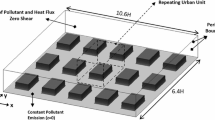Abstract
The Computational Fluid Dynamics code CFX-TASCflow is used for simulating the wind flow and pollutant concentration patterns in two-dimensional wind-tunnel models of an urban area. Several two-dimensional multiple street canyon configurations are studied corresponding to different areal densities and roof shapes. A line source of a tracer gas is placed at the bottom of one street canyon for modelling street-level traffic emissions. The flow fields resulting from the simulations correspond to the patterns observed in street canyons. In particular and in good agreement with observations, a dual vortex system is predicted for a deep flat-roof street canyon configuration, while an even more complex vortex system is evidenced in the case of slanted-roof square street canyons. In agreement with measurement data, high pollutant concentration levels are predicted either on the leeward or the windward side of the street canyon, depending on the geometrical details of the surrounding buildings.
Similar content being viewed by others
References
Hosker R.P.: 1985, Flow around isolated structures and building clusters: A review, ASHRAE Trans. 91, 1671–1692.
Hussain M. and Lee B.E.: 1980, An investigation of wind forces on three-dimensional roughness elements in simulated atmospheric boundary layer flow: Part II Flow over large arrays of identical roughness elements and the effect and side aspect ratio variations, Report BS 56, Dept. Building Science, University of Sheffield.
Launder, B. E., and Spalding, D. B.: 1974, The numerical computation of turbulent flows, Comput. Meths. Appl. Mech. Eng. 3, 269–289.
Leitl, B.M. and Meroney, R.N.: 1997, Car exhaust dispersion in a street canyon. Numerical critique of a wind tunnel experiment, J. of Wind Eng. and Ind. Aerodynamics 67 &; 68, 293–304.
Oke T.R.: 1988, Street design and urban canopy layer climate, Energy Building, 11, 103–113.
Rafailidis, S. and Schatzmann, M.: 1995, Concentration measurements with different roof patterns in street canyons with aspect ratios B/H=1/2 and B/H=1, Report, Meteorology Institute, University of Hamburg.
Rafailidis, S.: 1997, Influence of building areal density and roof shape on the wind characteristics above a town, Boundary-Layer Meteorology 85, 255–271.
Raw, M.J., Galpin, P.F. and Hutchinson, B.R.: 1989, A collocated finite-volume method for solving the Navier-Stokes equations for incompressible and compressible flows in Turbomachinery: Results and applications, Canadian Aeronautics and Space Journal 35, 189–196.
Raw, M.J.: 1994, A coupled algebraic multigrid method for the 3D Navier-Stockes equations, Proceedings of the 10th GAMM-Seminar Kiel, January 14-16, 1994.
Rodi, W.: 1991, Experience with two-layer models combining the k-? model with a one-equation model near the wall, AIAA 91-0216, presented at the 29th Aerospace Sciences Meeting, Reno, Nevada, January 7-10, 1991.
Sini J.F., Anquetin S., and Mestayer P.G.: 1996, Pollutant dispersion and thermal effects in urban street canyons, Atmospheric Environment, 30 2659–2677.
Author information
Authors and Affiliations
Rights and permissions
About this article
Cite this article
Theodoridis, G., Moussiopoulos, N. Influence of Building Density and Roof Shape on the Wind and Dispersion Characteristics in an Urban Area: A Numerical Study. Environ Monit Assess 65, 407–415 (2000). https://doi.org/10.1023/A:1006421027428
Issue Date:
DOI: https://doi.org/10.1023/A:1006421027428




